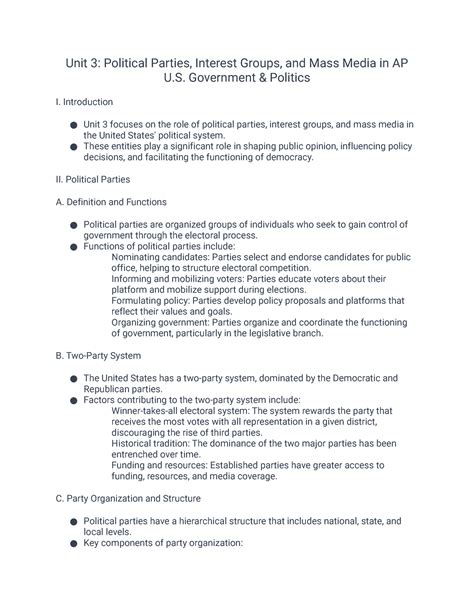Unit 3 of AP Government and Politics delves into the dynamic world of political parties and interest groups, their roles in the American political system, and their impact on policymaking. This comprehensive article provides a detailed overview of the key concepts and theories explored in this unit, offering students a solid foundation for understanding these influential entities.

Political Parties: Structure, Functions, and Types
Structure and Organization:
– Political parties are composed of individuals who share similar political views and goals.
– They have a hierarchical structure with local, state, and national organizations.
– Formal rules and procedures govern party operations, including candidate nomination and policymaking.
Functions of Political Parties:
– Nominate candidates for public office.
– Mobilize voters and participate in elections.
– Articulate and promote party platforms and policies.
– Provide a sense of identity and community for members.
– Structure and simplify the political process for voters.
Types of Political Parties:
– Two-party system: A system where two dominant parties hold the majority of political power (e.g., Democrats and Republicans in the US).
– Multi-party system: A system where several parties share power and compete for votes (e.g., many European countries).
– One-party system: A system where a single party dominates and suppresses opposition (e.g., China).
Interest Groups: Influence, Advocacy, and Mobilization
Nature and Types of Interest Groups:
– Interest groups represent the interests of specific segments of society, such as businesses, labor unions, environmentalists, or religious groups.
– They can be formal organizations (e.g., the National Rifle Association) or informal coalitions (e.g., the anti-abortion movement).
Influence Strategies:
– Lobbying: Directly contacting legislators and government officials to influence policy.
– Campaign contributions: Providing financial support to candidates who support their interests.
– Public relations: Shaping public opinion through advertising and media campaigns.
– Litigation: Using legal means to advance their causes.
Mobilization of Members and the Public:
– Interest groups engage in grassroots mobilization by rallying members and the public to support their positions.
– They organize protests, petition drives, and letter-writing campaigns.
– They use social media and other forms of communication to reach their target audiences.
Relationships Between Political Parties and Interest Groups
Collaboration and Cooperation:
– Interest groups often align with political parties that share their ideological views.
– Parties rely on interest groups for financial support, volunteers, and policy expertise.
Competition and Conflict:
– Interest groups can compete with each other for influence over parties and policies.
– Parties may distance themselves from groups that become too controversial or unpopular.
Consequences of Political Parties and Interest Groups
Positive Consequences:
– Channel political participation: Parties and interest groups provide avenues for citizens to voice their concerns and influence policy.
– Represent diverse interests: They ensure that a wide range of societal interests are represented in the political arena.
– Hold government accountable: They monitor government actions and hold officials accountable for their decisions.
Negative Consequences:
– Polarization and gridlock: Competition between parties and interest groups can lead to political polarization and make it difficult to reach consensus.
– Special interests over public interests: Critics argue that parties and interest groups can prioritize their narrow agendas over the broader interests of the public.
– Campaign finance corruption: Interest group contributions can give wealthy individuals and corporations undue influence over elections.
Tables: Key Statistics and Information
| Statistic | Source | Year |
|---|---|---|
| Number of registered voters in the US | US Census Bureau | 2020 |
| Percentage of Americans who identify as Democrats | Gallup | 2022 |
| Percentage of Americans who identify as Republicans | Gallup | 2022 |
| Number of interest groups registered in the US | Center for Responsive Politics | 2022 |
| Amount spent on lobbying in Washington, DC | Center for Responsive Politics | 2022 |
FAQs: Commonly Asked Questions
- What is the difference between a political party and an interest group?
- How do interest groups influence the government?
- What are the advantages and disadvantages of political parties?
- What are the major types of interest groups in the US?
- How can citizens participate in the political process through parties and interest groups?
- What are some of the challenges facing political parties and interest groups today?
Conclusion
Political parties and interest groups are vital components of the American political system. They play a crucial role in articulating and promoting political ideas, mobilizing voters, and influencing policy decisions. Understanding the structure, functions, and dynamics of these organizations is essential for comprehending the complexities of the American political landscape and the challenges facing our democracy in the 21st century.
